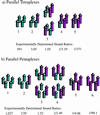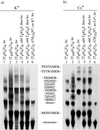A DNA pentaplex incorporating nucleobase quintets
- PMID: 10485874
- PMCID: PMC17931
- DOI: 10.1073/pnas.96.19.10614
A DNA pentaplex incorporating nucleobase quintets
Abstract
Supramolecular self-assembly is an integral step in the formation of many biological structures. Here we report a DNA pentaplex that derives from a metal-assisted, hydrogen bond-mediated self-assembly process. In particular, cesium ions are found to induce pentameric assembly of DNA bearing the nonstandard nucleobase iso-guanine. The pentaplex was designed by using a simple algorithm to predict nucleobase structural requirements within a quintet motif. The design principles are general and should extend to complexes beyond pentaplex. Structures exhibiting molecularities of five or more were previously accessible to peptides, but not nucleic acids.
Figures






Similar articles
-
Beyond guanine quartets: cation-induced formation of homogenous and chimeric DNA tetraplexes incorporating iso-guanine and guanine.Chem Biol. 1997 Dec;4(12):899-908. doi: 10.1016/s1074-5521(97)90298-2. Chem Biol. 1997. PMID: 9427655
-
Solution structure of a parallel-stranded oligoisoguanine DNA pentaplex formed by d(T(iG)4 T) in the presence of Cs+ ions.Angew Chem Int Ed Engl. 2012 Aug 6;51(32):7952-5. doi: 10.1002/anie.201203459. Epub 2012 Jul 5. Angew Chem Int Ed Engl. 2012. PMID: 22767484 No abstract available.
-
Quintets of uracil and thymine: a novel structure of nucleobase self-assembly studied by electrospray ionization mass spectrometry.Chem Commun (Camb). 2009 May 28;(20):2863-5. doi: 10.1039/b903857d. Epub 2009 Mar 30. Chem Commun (Camb). 2009. PMID: 19436891
-
Cations as hydrogen bond donors: a view of electrostatic interactions in DNA.Annu Rev Biophys Biomol Struct. 2003;32:27-45. doi: 10.1146/annurev.biophys.32.110601.141726. Epub 2003 Feb 14. Annu Rev Biophys Biomol Struct. 2003. PMID: 12598364 Review.
-
Nucleic acid encoding to program self-assembly in chemical biology.Chem Soc Rev. 2008 Jul;37(7):1330-6. doi: 10.1039/b706610b. Epub 2008 Apr 17. Chem Soc Rev. 2008. PMID: 18568159 Review.
Cited by
-
Heme activation by DNA: isoguanine pentaplexes, but not quadruplexes, bind heme and enhance its oxidative activity.Nucleic Acids Res. 2015 Apr 30;43(8):4191-201. doi: 10.1093/nar/gkv266. Epub 2015 Mar 30. Nucleic Acids Res. 2015. PMID: 25824944 Free PMC article.
-
Density functional study of isoguanine tetrad and pentad sandwich complexes with alkali metal ions.J Mol Model. 2007 Feb;13(2):335-45. doi: 10.1007/s00894-006-0148-5. Epub 2006 Sep 30. J Mol Model. 2007. PMID: 17013632
-
In What Ways Do Synthetic Nucleotides and Natural Base Lesions Alter the Structural Stability of G-Quadruplex Nucleic Acids?J Nucleic Acids. 2017;2017:1641845. doi: 10.1155/2017/1641845. Epub 2017 Oct 18. J Nucleic Acids. 2017. PMID: 29181193 Free PMC article. Review.
-
Assessing Readability of an 8-Letter Expanded Deoxyribonucleic Acid Alphabet with Nanopores.J Am Chem Soc. 2023 Apr 10:10.1021/jacs.3c00829. doi: 10.1021/jacs.3c00829. Online ahead of print. J Am Chem Soc. 2023. PMID: 37036666 Free PMC article.
-
Thermodynamic stability of base pairs between 2-hydroxyadenine and incoming nucleotides as a determinant of nucleotide incorporation specificity during replication.Nucleic Acids Res. 2001 Aug 15;29(16):3289-96. doi: 10.1093/nar/29.16.3289. Nucleic Acids Res. 2001. PMID: 11504865 Free PMC article.
References
-
- Drain C M, Nifiatis F, Vasenko A, Batteas J D. Angew Chem Int Ed Engl. 1998;37:2344–2347. - PubMed
-
- Huck W T S, van Veggel F C J M, Reinhoudt D N. Angew Chem Int Ed Engl. 1996;35:1213–1215.
-
- Linton B, Hamilton A D. Chem Rev. 1997;97:1669–1680. - PubMed
-
- Hasenknopf B, Lehn J M, Boumediene N, Leize E, Dorsselaer A V. Angew Chem Int Ed Engl. 1998;37:3265–3268. - PubMed
-
- Kang C H, Zhang X, Ratliff R, Moyzis R, Rich A. Nature (London) 1992;356:126–131. - PubMed
Publication types
MeSH terms
Substances
LinkOut - more resources
Full Text Sources

